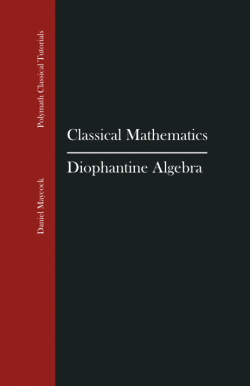
Primary Sources
Diophantine Algebra is a 6-week algebra supplement conceived as a brief sequel to Classical Mathematics ONE (CM1). However, Diophantine Algebra was designed to also be usable by students who have not completed CM1.
Just as CM1 serves to guide students through one of the great books of mathematics ( books I-III, V, VI of Euclid’s Elements), Diophantine Algebra guides students through a selection of problems from Diophantus’ Arithmetica. In other words, Diophantine Algebra is not a textbook in the usual sense. Instead, it provides a structured way for students to read the Arithmetica for themselves.
Diophantine Algebra will expose students to Diophantus’ “rhetorical algebra” (i.e. doing math with words rather than mere symbols), which will improve their ability to think through word problems and real-world math scenarios. The math presented through Diophantine Algebra is about the level of Algebra 1, but Diophantus’ presentation of it makes this guidebook also suitable for more advanced students (students should have at least one semester of Algebra 1 before using this guidebook).
Diophantus of Alexandria
Diophantus was a Greek mathematician who probably lived some time between the 3rd and 4th century A.D. It’s easy to understate the importance of Diophantus in the history of mathematics. Viete’s Five Books of Zetetica are an algebraic expansion of Diophantus’ Arithmetica, and even the mathematical giants Euler and Fermat were fascinated by Diophantus’ problems and wrote about them.
Why Diophantus’ Arithmetica?
Although he is often called “The Father of Algebra,” his work is almost entirely absent from modern high school math curricula. Diophantus is ignored for two reasons: his work is difficult to understand and roughly corresponds to what is typically studied in Algebra 1. There are easier ways to study Algebra 1, but there may be no better way than studying Diophantus’ work directly to see the relationship between ratio and equation.
Another benefit of studying Diophantus is that students will learn to read and understand word problems. Word problems are a bane to many students, but Diophantus, lacking the efficiency of modern algebraic notation, wrote his problems almost entirely in words rather than symbols. Thus, once a student learns to work through problems in Diophantus’ “rhetorical algebra” traditional word problems will no longer be perplexing, and students will have learned invaluable skills of mathematical analysis.
Guidebook
The guidebook includes 6 weeks of lessons designed to teach the following topics:
- Resolving a proportion into an equations
- Solving proportions and equations for given unknowns
- Writing expressions relating two unknown quantities, given a particular sum, difference, or ratio
- Solving systems of equations employing up to four equations with four variables (NB: These systems of equations are contrived by Diophantus to be solved by his particular method and are therefore different from the four-variable linear systems often taught using matrices in Algebra 2 or Precalculus.)
- Solving second-degree problems that are reducible to the first degree
- Using the Pythagorean Theorem to produce right triangles
- Using the Pythagorean Theorem to determine whether a triangle is right
- Translating rectangular geometric figures into algebraic form
- Form and properties of binomial squares
Because the guidebook is a guidebook and not a traditional textbook, it assigns readings from the following texts, which will need to be purchased separately from Diophantine Algebra.
- Diophantus of Alexandria by T. L. Heath (This text contains a translation of the Arithmetica that serves as the primary text. Because the copyright is expired, you may be able to find PDF versions online for free.)
- Euclid’s Elements (preferably the Green Lion Press edition)
- Mathematics for the Nonmathematician by Morris Kline
Solution Guide
To accompany the guidebook, Diophantine Algebra includes a Solution Guide that contains annotated solutions to the response problems assigned in the guidebook. We’ve worked to make this Diophantine Algebra as teacher-friendly as possible, so the solutions are thorough and include additional notes when necessary to clarify the reasoning behind the solution methods. As a result, the Solution Guide contains nearly as many pages as the guidebook.
Feature Summary
Guidebook
- 6 weeks of lessons (Cycles)
- 4 lessons (Epicycles) per week
- plenty of response problems for reinforcement & understanding
- Daily introductions provide context for each lesson
- Spiral bound to lie flat
- 57 pages
Solution Guide
- Annotated solutions to response problems in guidebook
- Easy-to-navigate layout
- Spiral bound to lie flat
- 55 pages
Buy now
$24.99 plus $8.00* shipping**
Includes
- Student Guidebook
- Solution Guide
Please note that the other required texts (Diophantus’ Arithmetica, Euclid’s Elements, Mathematics for the Nonmathematician) will need to be purchased separately elsewhere.
Our orders are processed using Stripe. Clicking the order button will re-direct you to our Stripe product page(s) for payment processing.
* Please note that we now ship orders via USPS media mail. While media mail does not usually cost $8, the difference goes toward keeping our prices steady in the face of rising rising production and handling costs. Thanks for understanding!
** Right now, we ship only within the continental United States. If you are interested having the curriculum shipped elsewhere, please contact us, and we’ll see what we can do.
If you have any trouble with the payment buttons on our site, please email Daniel at help@polymathclassical.com.